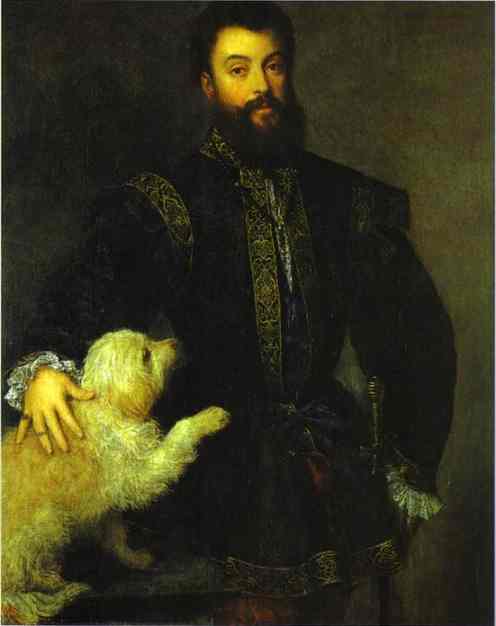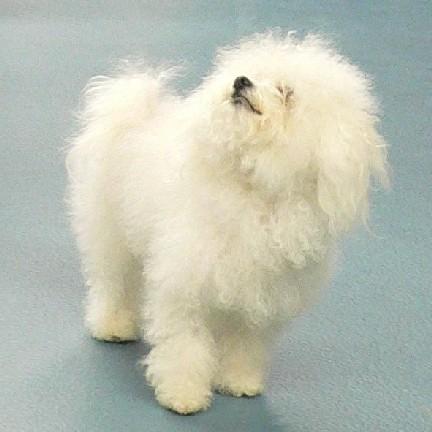

Breedstandard
|
|
|
VALID FROM 01/01/2016
FCI-Standard N° 196
BOLOGNESE
TRANSLATION: Mrs. Peggy Davis. Revised by Renée Sporre-Willes. Official
language (EN).
ORIGIN: Italy.
DATE OF PUBLICATION OF THE OFFICIAL VALID STANDARD: 13.11.2015.
UTILIZATION: Companion dog.
FCI-CLASSIFICATION: Group 9 Companion and Toy Dogs.
Section 1 Bichons and related breeds.
Without working trial.
BRIEF HISTORICAL SUMMARY: The origin of the Bolognese is confused with
that of the Maltese, because their distant ancestors are the same little dogs
mentioned in Latin by Aristotle (384–322 B.C.) under the denomination of canes
melitenses. Bolognese, already known in the Roman era appears most especially
among the very appreciated gifts, which were made during a whole era by the
people of power of that world. Cosimo de Medici (1389–1464) brought no less than
eight to Brussels as gifts to as many Belgian noblemen. Philipe II, king of
Spain 1556–1598, after having received two as a gift from the Duke d’Este,
thanked him in writing saying, ” These little dogs are the most royal gifts one
can give to an emperor”. Bolognese are represented in paintings by Titian,
Pierre Breughel called le Vieux and Goya.
GENERAL APPEARANCE: Small size, stocky and compact, covered with a pure white
coat, long and fluffy.
IMPORTANT PROPORTIONS: Square built, the length of the body being equal to the
height at the withers. Length of head reaching 1/3 of the height at the withers.
Depth of chest almost half of the height at the withers.
FCI-St. N° 196 / 17.12.2015
BEHAVIOUR / TEMPERAMENT: Very serene, generally not very active. Eventful
but calm very faithful to his master and his entourage.
HEAD: Medium long. The width, measured at the level of the zygomatic
arches is the same as the length.
CRANIAL REGION:
Skull: Slightly ovoid in shape (egg-shaped) in the sagittal direction and
has rather convex sides; rather flat in its upper part. The protuberances of the
frontal bones are well developed. The longitudinal axes of the skull and muzzle
are parallel; the frontal furrow is only slightly accentuated, as is also the
occipital protuberance. The length of the skull is slightly more than that of
the muzzle.
Stop: Rather accentuated.
FACIAL REGION:
Nose: Set on the same line as the topline of the muzzle: seen in profile
the front is vertical. Large and must be black.
Muzzle: Its length is equal to 2/5 of the length of the head; the topline
of the muzzle is straight and the sides of the muzzle are parallel, so that the
forepart of the muzzle is almost square. The lower orbital region is well
chiselled.
Lips: Upper lips being only slightly developed in depth, they do not
cover the bottom lips, and the lower profile of the muzzle is determined by the
lower jaw.
Jaws/Teeth: Jaws normally developed, with top and bottom arches perfectly
adapted. Teeth white evenly aligned, with strong and complete dentition.
Articulation of incisors as scissor bite; pincer bite tolerated.
Eyes: Set on an almost frontal plane; size slightly superior to normal.
Eyelid opening is round; the eyeball must not be prominent; the white of the eye
is not visible. The rims of the eyelids must be black, and the iris of a dark
ochre colour.
Ears: High set, they are long and hanging, but rather rigid at their
base, so that the upper part of the external ear is detached from the skull,
giving thus the impression of the head being larger than it really is.
NECK: Without dewlap: its length is equal to the length of the head.
BODY: The dog being of a square construction, the length of the body,
measured from the point of the shoulder to the point of the buttock bone is
equal to that of the height at the withers.
Top line: The straight profile of the back, and that of the loin,
slightly convex, merge harmoniously in the line of the croup.
Withers: Only slightly prominent above the top line. Top of shoulder
blades well spaced.
Back: Straight.
Loin: Short, strong, slightly convex.
Croup: Very broad and only slightly sloping.
Chest: Ample, let down to level of elbows, with well-sprung ribs, the
height reaching almost half of the height at the withers. The point of the
sternum is only slightly prominent.
Underline and belly: Following the profile of the sternum, then rises
slightly towards the belly.
TAIL: Set in the line of the croup, carried curved over the back.
LIMBS
FOREQUARTERS:
General appearance: Forearms are perfectly straight and parallel in
relation to the median plane of the body.
Shoulder: The length of the shoulder blades is equal to 1/4 of the height
of the withers; in relation to the horizontal, they are slanting and are near
the vertical in relation to the median plane of the body.
Upper arm: Well joined to the body, of an almost equal length to that of
the shoulder, but less slanting.
Elbow: They are on a parallel plane to the median plane of the body.
Forearm: The length is equal to that of the upper arm; follows a perfect
vertical direction.
Metacarpus (Pastern): Seen from the front they continue the vertical line
of the forearm. Seen in profile the pastern is slightly slanting.
Forefeet: Oval shaped, with well cushioned dark pads and very hard black
nails.
HINDQUARTERS:
General appearance: Viewed from behind, the hind legs must follow from
the point of the buttock bone to the ground in a perfectly vertical line - legs
are parallel to each other.
Thigh: Length is equal to 1/3 of the height at the withers. Slanting from
top to bottom and back to front and perfectly parallel to the median plane of
the body.
Stifle (Knee): Firm, not very angled.
Lower thigh: Longer than the thigh.
Hock joint: The tibio-tarsal angle is not very closed.
Metatarsus (Rear pastern): The distance from the point of the hock to the
ground is slightly less than a third of the height at the withers.
Hind feet: Same characteristics as the forefeet, but less oval.
GAIT / MOVEMENT: Free, energetic, with a noble and distinguished head
carriage.
SKIN: Taut and tightly fitted to the body all over, the visible mucous
membranes and the third eyelids strictly pigmented black.
COAT
Hair: Long all over the body, from head to tail, from the top line to the
feet. It is shorter on the muzzle. Forms long flocks that have the same texture
all over the body, rather off-standing coat thus not falling flat and tight,
never shows fringes.
Colour: Pure white, very slight shades of ivory are not disqualifying.
SIZE AND WEIGHT:
Height at the withers:
Males: 27 – 30 cm.
Females: 25 – 28 cm.
Weight: 2.5 – 4 kg.
FAULTS: Any departure from the foregoing points should be considered a
fault and the seriousness with which the fault should be regarded should be in
exact proportion to its degree and its effect upon the health and welfare of the
dog.
Strabismus (Squinting).
SEVERE FAULTS:
Accentuated convergence or divergence of the upper longitudinal axes.
Convex muzzle (Roman nose).
Undershot.
Size in males under 25 cm and over 33 cm and size in females under 22 cm or
over 32 cm.
DISQUALIFYING FAULTS:
Aggressive or overly shy dogs.
Any dog clearly showing physical or behavioural abnormalities shall be
disqualified.
Depigmentation of the nose.
Nose of any other colour than black.
Undershot - very exaggerated with teeth showing and mal-shaped muzzle.
Bilateral depigmentation of the eyelids.
Wall-eyed.
Tail less.
Shortened tail whether natural or artificial.
Any other colour than white.
Patches and flecks.
N.B.:
Male animals should have two apparently normal testicles fully descended into
the scrotum.
Only functionally and clinically healthy dogs, with breed typical conformation
should be used for breeding.